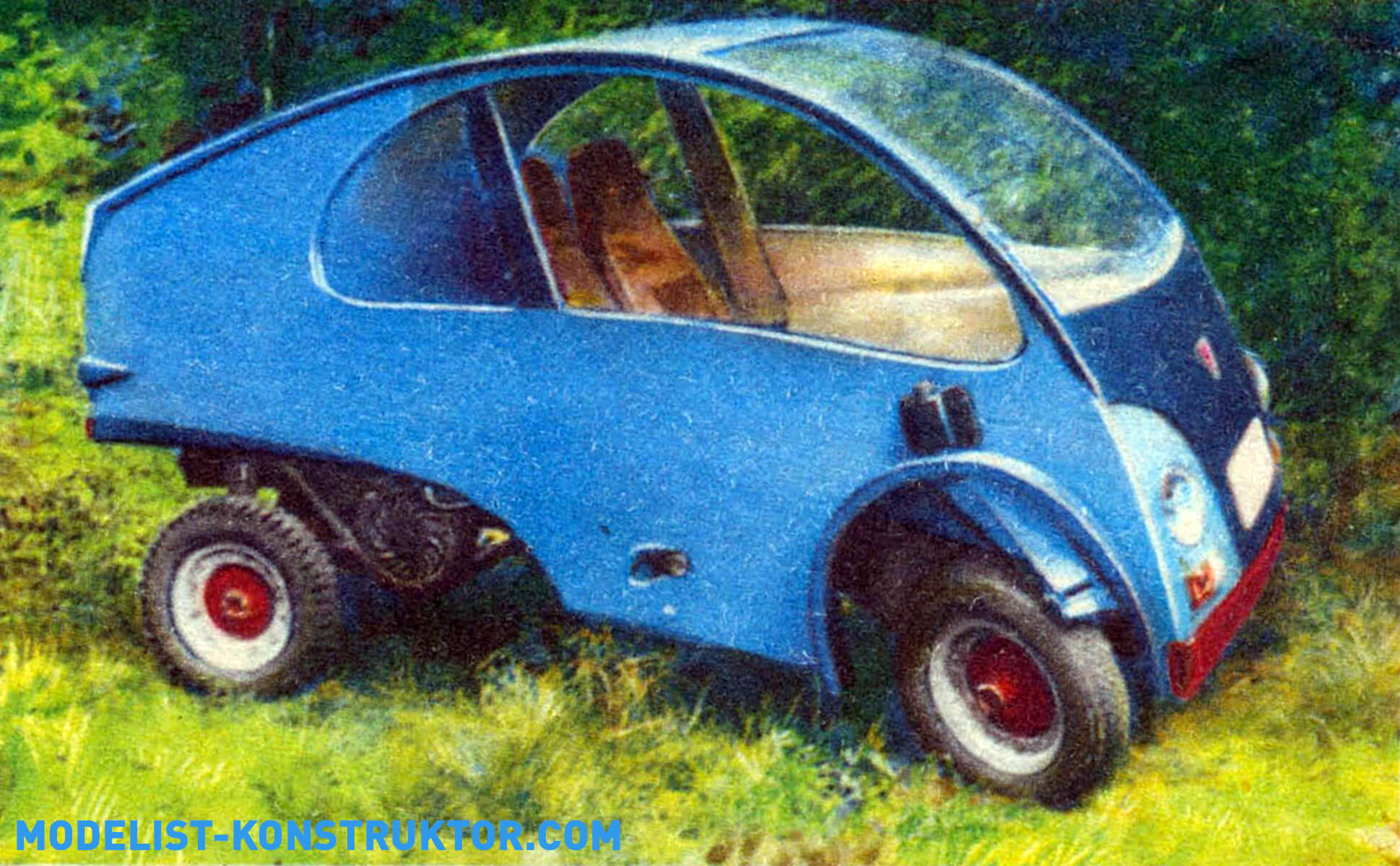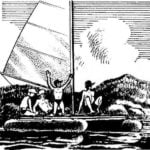A motorcycle is an individual vehicle that, as the name suggests, combines the qualities of both a car and a motorcycle. It goes without saying that, whenever possible, the advantages of these vehicles were combined while eliminating their disadvantages as much as possible.
“Ruta” is an extremely simple, quite comfortable, highly economical and inexpensive to manufacture car, intended for individual use as a city or pleasure car, as well as a car for summer residents, capable of carrying a driver with a passenger and not too bulky luggage. “Ruta” is also quite suitable as a vehicle for disabled people and the elderly.
As already mentioned, the motor vehicle can carry two people with luggage up to 40 kg at a speed of up to 60 km/h. Fuel consumption is 4.2 liters per 100 km.
The design of the car was based on the well-known ergonomic principle of choosing the driver or passenger as the core of the vehicle, together with comfortable car seats. The geometric parameters of such a core become the main ones when drawing a fairly spacious shell – the body of the future vehicle. Of course, the most rational arrangement of the main components and assemblies of the machine is also taken into account. As a result of this kind of design, the shape of the shell turned out to be egg-shaped (when viewed from the side), having the greatest strength with a rational ratio between the volume and its total surface. This shape, in addition, has little aerodynamic resistance, but it can be further reduced if the body is somewhat elongated in the direction of travel and narrowed at the rear.

1,2 – mounting points for the power unit subframe, 3, 4 – mounting bolts for the rear part of the subframe, 5 – power unit subframe, 6 – motor vehicle frame, 7 – passenger seat, 8 – driver’s seat, 9 – steering lever, 10 – trunk lid , 11 — door, 12 — door lock, 13 — steering rod, 14 — battery, 15 — fuel tank, 16 — front wheel swivel strut.
The layout of the machine is unconventional. Its body has no doors – to enter the car there is a hatch in the front part of it, the cover of which forms the wall of the body with part of its roof. This lifting door allows you to enter the car almost without bending, which is especially important for disabled people and the elderly. The trunk lid is designed in a similar way – it also folds up. As can be seen from the drawings, this cover is located almost horizontally, so to improve visibility it has a significant glass area.
The machine is four-wheeled, it is designed according to a symmetrical design with steered front and closely spaced rear drive wheels. This design has a number of advantages over the traditional one: in particular, it makes it possible to make the machine lighter, more technologically advanced and inexpensive to manufacture, and quite maneuverable while maintaining sufficient stability.
To reduce noise inside the cabin and the penetration of fuel vapors, oils and exhaust gases into it, all motor vehicle units are located outside the cabin capsule. In addition, this allows you to significantly simplify machine maintenance.


1 – trailing swing arm, 2 – shock absorber (from a heavy or medium motorcycle), 3 – swing arm of the strut, 4 – glass, 5 – axis of the swing arm of the strut, 6 – angular contact bearings, 7 – bushing, 8 – bearing, 9 — axle of the trailing arm of the suspension, 10 — front wheel of a motor vehicle, 11 — wheel axle, 12 — fist.
The front steered wheels are mounted together with swivel struts and suspensions on the sides of the motor vehicle body. The rear wheels, together with the power unit, form a single unit located in the rear of the car.
The suspension of the front wheels and the principle of their control are borrowed from aviation – the controlled landing gear is designed in almost the same way. On the Ruta, the left and right suspensions are designed according to the design with a trailing swing arm and a remote hydraulic shock absorber from a medium or heavy motorcycle. The main power element of such a rack is a rotary lever, to which an axis is welded, mounted in a glass on two angular contact bearings. A bushing is welded to the lower part of the swing arm, in which the axis of the trailing arm of the suspension is hinged on two bearings. At the end of this lever there is an axle on which the front wheel rotates. A fist is welded into the upper part of the lever, with the help of which the entire rack can rotate around its axis. It is characteristic that the swing arm and the front wheel are located in the same plane – this makes it possible to keep the width of the wheel arch to a minimum.

1 — steering lever, 2, 3 — left and right steering levers, 4 — steering shaft, 5, 6 — steering shaft levers, 7, 8 — left and right tie rods, 9, 10 — right and left knuckles, 11, 12 — right and left rotary struts, 13, 14 — left and right hinge units of the strut rotary arm, 15, 16 — a pair of spur gears.
The stand with suspension and wheel are a separate assembly unit, and it is installed outside the motor vehicle, separately. And after assembly, the finished unit is secured to the body using bolts and nuts and covered with a mud flap.
The steering system on the Ruta differs from the classic one. The fact is that the use of a conventional steering linkage on a motor vehicle would lead to unnecessary overcomplication of its front part, and the presence of a steering wheel would significantly complicate getting into and out of the motor vehicle. Moreover, a motorized vehicle, which, in essence, is the Ruta, can be equipped with simpler and cheaper motorcycle controls.
The solution found for the steering of a motorcycle differs little from that of a motorcycle, especially when two handles are used for steering. To be fair, it should be noted that you can operate the car with one hand – this option is especially interesting for people with disabilities.


1 – subframe, 2 – T-200M engine, 3, 4 – right and left wheels of the power unit, 5 trailing arm of the wheel suspension, 6 – axle, 7 – eye, 8 – shock absorber (from a medium or heavy motorcycle), 9 – chain rear wheel drive, 10 – Hooke joints, 11 – connecting shaft.
The figures show two options for the control system – with two handles and with one. In the second option, the force is transferred from the handle to the wheels through a rotary shaft installed under the seats, and then through two levers welded at the ends of the shaft, the forces are transferred to the left and right rods, which are connected to the fists of the left and right rack, respectively. In this case, the stand, together with the wheel and suspension, rotates at an angle proportional to the angle of deflection of the machine control lever. The rods are connected to the levers and knuckles using ball pins; The rods also have the ability to adjust their length to adjust the toe angle of the wheels. Adjusting the angle of rotation of the wheel is achieved by selecting the angles of the levers relative to each other.
The control system option – with two steering arms – requires the use of a split rotary shaft, the halves of which are kinematically connected to each other using a pair of spur gears. In this case, each control handle is welded to the right or left half-shaft, respectively, the end levers will be directed in one direction (down). The use of a gear connection of the half-shafts allows them to rotate synchronously in mutually opposite directions in accordance with the movement of the steering levers.

1 — eye (steel strip 5 mm thick), 2 — spar (steel pipe with a diameter of 30 mm), 3 — fork. 4 — support platform (steel strip 5 mm thick), 5 — upper shock absorber support (steel strip 4 mm thick), 6 — rear cross member (square steel pipe), 7 — front cross member (steel pipe 30 mm in diameter).
The steering mechanism used on the Ruta is structurally simple and, importantly, allows the driver to control the motorcycle like a motorcycle, directly, without any transmission mechanism. Accordingly, the load on the steering handles does not exceed the load on the handlebars of a motorcycle with a side trailer – this is explained by the low weight of the motor vehicle and the small wheelbase.
It should be noted that a regular steering wheel can be easily mounted on the Ruta, and its shaft and steering mechanism are connected in almost the same way as already described for the lever steering mechanism.
The power unit is also unconventionally designed on the Ruta. As mentioned above, the engine, transmission and rear wheels are a single unit mounted on a special subframe. The basis of the power plant is a two-stroke engine with a displacement of 200 cubic meters. cm power 14 hp from the “Tourist” scooter. The engine is mounted on a subframe between the two rear wheels. The latter are suspended from the subframe on trailing arms, which swing on axles fixed in the eyes. Motorcycle shock absorbers are used as elastic suspension elements.

The drive from the engine is carried out using a bush-roller motorcycle chain only to the right wheel. The left wheel is connected to the right using a shaft and a pair of Hooke’s hinges.
The rear wheel track is chosen to be 580 mm, which, with wheels with a diameter of about 460 mm, makes it possible to do without a differential, while wheel slippage when cornering is insignificant.
The fuel tank is mounted at the top of the subframe, between the rear wheels. The fuel mixture is supplied to the engine carburetor by gravity, as in any motorcycle. To somewhat protect the engine from dirt and water, the wheels are covered with mud flaps.
As mentioned above, the power unit is an independent assembly unit, including an engine, drive, suspension with wheels and a fuel tank. This entire unit is assembled on a subframe and then secured in the rear part of the motor vehicle body, on two hinges of its frame. In the upper part, the power unit is secured with a pair of easily removable bolts with nuts and washers. This type of fastening of the power unit allows you to service and repair it without completely disconnecting it from the machine, but only by lifting its tail part – while the upper mounting bolts of the power unit must be unscrewed.
The Ruta power unit can also be used independently – for example, as the basis of a walk-behind tractor or as a motorized tractor for a cargo trolley or other agricultural implements.
Eduard RUDYK, Kyiv



